| |
|
1963 Familia Van (1st Generation) |
|
| |
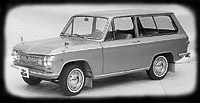 |
The first member of the Familia line was the 1963 Familia Van. It was not a van by American standards; rather, it was a small 3-door wagon. It was powered by a small 782cc OHV 4-cylinder engine that produced 42 hp @ 6000rpm and 43.5 lb-ft @ 3200 rpm. It weighed 1,675 pounds and seated 4 passengers. The Familia Van was produced primarily as a commercial vehicle.
|
|
| |
|
1964 Familia 800 Sedan |
|
| |
(Picture coming soon) |
Following the success of Mazda’s first passenger cars (R360 and its successor, the Carol), the Familia sedan was introduced. The sedan was nearly identical to the Familia Van and shared the same 782cc 4-cylinder engine and its rear-wheel drive layout. The new Familia was a huge success with its aluminum alloy engine, 5-bearing crankshaft, 115 km/h (71 mph) top speed, and 5-passenger capacity. It weighed 1,631 pounds.
|
|
| |
|
1965 Familia 1000 Coupe |
|
| |
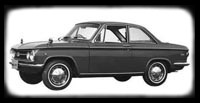 |
One year following the introduction of the Familia 800 Sedan, Mazda introduced the more powerful Familia 1000 Coupe. This 2-door used a 1.0L (985cc) OHV 4-cylinder engine, producing 68 hp @ 6500 rpm and 59 lb-ft @ 4,600 rpm. Weight increased to 1,740 pounds (111 pounds more than the sedan), but top speed increased to 145 km/h (90 mph).
|
| |
|
1967 Familia (2nd Generation) |
|
| |
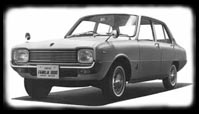 |
The Familia line was refreshed for 1967. The new body style still included the sedan, coupe, and van. The 1.0L OHV 4-cyl engine was improved for fuel efficiency and emissions, but power sacrificed and fell to 58 hp @ 6000 rpm and 57 lb-ft @ 3500 rpm. Larger engines were introduced. In 1968, a 1.2L OHV 4-cyl engine was introduced that produced 68 hp. In 1970, Mazda added a 1.3L SOHC 4-cyl engine, producing 75 hp. 1970 also saw the 1.0L 4-cyl engine make the switch to SOHC, although power output remained the same as the OHV version. Models were named according to their engine size: Familia 1000 (1.0L 4-cyl), Familia 1200 (1.2L 4-cyl), and Familia 1300 (1.3L 4-cyl).
|
| |
|
1969 Familia Presto Rotary Coupe |
|
| |
(Picture coming soon) |
Mazda added the venerable rotary engine to the Familia Coupe in 1969. In Japan, the car was known as the Familia Presto Rotary Coupe. The engine was a slightly detuned version of the 1.0L 10A rotary found in the Cosmo 110S and produced 100 hp @ 7000 rpm and 98 lb-ft @ 3500 rpm.
|
| |
|
1970 R100 and 1200 |
|
| |
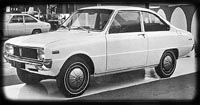 |
1970 marked a giant milestone for Mazda. This was the first year vehicles were sold in the extra-lucrative North American market. The Familia Presto Rotary Coupe was rebadged the R100, while the 1.2L version of the Familia sedan, coupe, and van (station wagon) were rebadged the 1200. The R100 and 1200 were sold until 1972. Road and Track magazine, in their review of the R100, said, “the Mazda R100 coupe is one helluva nice little car.” 1970 marks the beginning of a long life for the Familia platform in the United States, and the beginning of praise and enthusiasm for the later models (GLC, 323, Protegé).
|
| |
|
1973 Familia (3rd Generation) |
|
| |
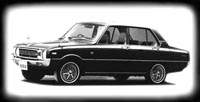 |
After an uncharacteristically long design cycle, Mazda redesigned the Familia in 1973. The platform was still rear wheel drive and used the 1.3L SOHC 4-cyl engine rated at 87 hp @ 6000 rpm and 80 lb-ft @ 3500 rpm.
|
| |
|
1977 Familia/GLC (4th Generation) |
|
| |
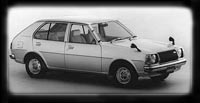 |
In 1977, Mazda adhered to the typical 4-year Japanese design cycles and introduced an all-new Familia. This 4th Generation of the Familia was exported to the United States and sold as the GLC (Great Little Car). Three engines were offered: 1.0L 4-cyl with 45 hp, 1.3L 4-cyl with 60 hp, and 1.5L 4-cyl with 70 hp @ 5700 rpm and 76 lb-ft @ 3500 rpm. It was offered as a hatchback, sedan, or wagon.
|
| |
|
1980 Familia/GLC (5th Generation) |
|
| |
(Picture coming soon) |
1980 brought another major milestone to Mazda. The fifth generation Familia/second generation GLC was the first Mazda vehicle to feature front-wheel drive. The 1.5L SOHC 4-cyl was re-engineered to provide more power (85 hp @ 5500 rpm and 89 lb-ft @ 3500 rpm) and better fuel economy. The Familia/GLC was offered as a sedan and three- and five-door hatchbacks. A wagon was also offered, but it was the same wagon offered since 1977.
|
| |
|
1985 Familia/323 (6th Generation) |
|
| |
(Picture coming soon) |
The Familia was redesigned for 1985 and debuted as the sixth generation of the platform. The GLC name was dropped in the United States and the vehicle gained the 323 nameplate. The engine was increased to an 82 hp 1.6L 4-cyl and retained the GLC’s front-wheel drive and fully independent suspension including the first application of Mazda’s patented Twin-Trapezoidal Link (TTL) rear suspension. A sedan, 3-door hatchback, and wagon were sold. Ford’s long-standing ties with Mazda produced a clone, the Mercury Tracer. The Tracer was offered as a three- or five-door hatchback. 1988 saw the first performance renditions of the 323: the 132 hp DOHC 16-valve turbocharged and intercooled 323 GT, and the 132 hp DOHC 16-valve turbocharged and intercooled all-wheel drive (AWD) 323 GTX.
|
| |
|
1990 Familia/323/Protégé (7th Generation) |
|
| |
(Picture coming soon) |
The 1990 model year brought some big changes to the Familia/323 lineup. The Familia continued as a three-door hatchback, five-door hatchback, and four-door sedan. In the United States, only a three-door hatchback and four-door sedan were sold. The hatchback continued with the 323 nameplate, while the four-door sedan was renamed Protégé. The 323 continued to use the 82 hp 1.6L DOHC 4-cylinder. The Protégé was available with either the 103 hp 1.8L SOHC 4-cylinder in DX trim, or the 125 hp 1.8L DOHC 4-cylinder engine. Front-wheel drive and a fully independent suspension, including Mazda’s patented Twin-Trapezoidal Link (TTL) rear suspension, were still used, although an all-wheel drive version was offered for the first two years. The 1991-1996 Mercury Tracer and Ford Escort were based on this 7th Generation platform, but used Ford’s 1.9L SOHC 4-cylinder on all models except the Escort GT and Tracer LTS. Mazda’s 1.8L DOHC was used in those models.
|
| |
|
1995 Familia/323/Protégé (8th Generation) |
|
| |
(Picture coming soon) |
The 1995 Familia/323/Protégé was the first vehicle to employ Mazda’s new OptiSpace design philosophy. In addition to pushing the wheels to the corners, all mechanical devices were designed to improve interior space. As a result, this 8th Generation enjoyed more interior room than many midsize sedans and even eclipsed Mazda’s newly released Millenia. The 323 nameplate was dropped in the U.S., and only the Protégé 4-door sedan was available. A three-door hatchback was available in other markets, but was only tested briefly in the U.S. The design still incorporated front-wheel drive and a fully independent suspension including Mazda’s patented Twin-Trapezoidal Link (TTL) rear suspension. An all new 1.5L DOHC 4-cylinder producing 92 hp powered the DX and LX Protégé models, while the 1.8L DOHC 4-cylinder continued to power the Protégé ES. A derivative of this platform was used as a basis for the 1992-1996 MX-3. However, the MX-3 used the previous generation 323’s 1.6L DOHC 4-cyl or Mazda’s tiny 1.8L DOHC V6.
|
| |
|
1999 Familia/323/Protégé (9th Generation) |
|
| |
(Picture coming soon) |
The 1999 Familia/323/Protégé was based on Mazda’s midsize Capella sedan. This 9th Generation was available as a four-door sedan or five-door hatchback. However, the five-door was not available in the U.S. until the 2002 model year. U.S. Protégé engines included a 103 hp 1.6L DOHC for 1999-2001 DX and LX models. An all-new 1.8L DOHC 4-cyl based on Mazda’s FS-series 2.0L with 122 hp and 120 lb-ft was used in the 1999-2000 ES models. The FS-series 130 hp 2.0L replaced the 1.8L in the 2001 ES models and was optional on the 2001 LX. For 2002, the 2.0L became standard for all trim levels including the new-to-the-U.S. Protege5.
|
| |
|
2001 Protégé MP3 |
|
| |
(Picture coming soon) |
For the first time since the 323 GT and GTX, a performance edition was introduced for the 2001 model year. Named for its sound system, the MP3 was limited to only 1,500 units. Upgrades over a Protégé ES of the same year included 140 hp, Racing Beat-tuned suspension, front strut tower brace, 17-inch Racing Hart alloy wheels, special body cladding, Kenwood sound system with trunk-mounted subwoofer, and special interior. Although it lacked power, the MP3 was unilaterally praised for its excellent handling. It was available in Vivid Yellow or Laser Blue.
|
| |
|
2002 Protegé5 |
|
| |
(Picture coming soon) |
Although this five-door hatchback was available outside the North American market since the 1999 model year, it was not imported to the U.S. until the 2002 model year. The Protege5 was available in a single trim level that was equivalent to the ES sedan. All Protege5’s came standard with an aggressive front bumper with large, round fog lamps; side skirts; and rear valance. 16-inch wheels came with the package, along with a rear spoiler and front strut tower brace, and the 130 hp 2.0L DOHC 4-cylinder engine. Leather became available along with a “Sport” auto-manual transmission. Both of these options were never previously offered in the GLC/323/Protégé line-up in the U.S.
|
| |
|
2003 Mazdaspeed Protégé |
|
| |
(Picture coming soon) |
This upcoming Protégé will be the first vehicle sold in the U.S. under the famous and impressive Mazdaspeed name. This new performance model will be similar to the 2001 MP3 but with the addition of a Callaway-tuned Garrett T-25 turbocharger, intercooler, and a limited-slip differential. Due to the stock transmission, power is limited to 170 hp but promises an extremely flat power-band and an extreme emphasis on handling. The Mazdaspeed Protégé will be limited to 2,000 units, available in Black or Spicy Orange.
|







